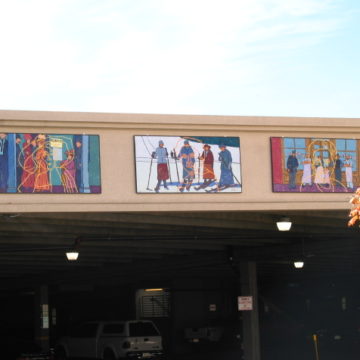
This artwork was deaccessioned in 2022. The murals now live within the History Colorado collection. The artworks can be found within the History Colorado Collection database by a search of “Anthony Ortega” and/or “Sylvia Montero”.
Artists: Tony Ortega and Sylvia Montero
Year: 2000
Dates: b. 1958, Santa Fe, NM and b. Denver, CO
Materials: Acrylic on plywood
Dimensions: 4′ x 8′ x 1/2″
About Women of the West
This mural project was originally produced by the Women of the West Museum for a site in Lower Downtown (LoDo) in 2000. The paintings were installed along a 250-foot-long construction barricade at 16 Market Street from January through September 2000. The four by eight foot murals feature eleven women who have contributed to the history of Colorado and each panel commemorates a different part of the state’s past and present. Denver artists Tony Ortega and Sylvia Montero created the murals. Each panel superimposes the image of a single woman over a group activity and are all based on historic photographs. The murals are hung in chronological order based on the date of the historic images.
The murals were donated to the Museum of Outdoor Arts in 2004 by the Autry National Center. In 2002, the Women of the West Museum merged with the Autry National Center based in Los Angeles, California. Through the suggestion of the artists, the murals were donated to the Museum of Outdoor Arts so they could remain in Colorado.
Biographies:
Clara Brown
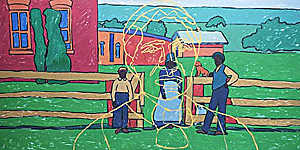
Clara Brown was born into slavery on a plantation near Fredricksburg, Virginia. In 1856, she was granted her freedom and headed west in search of her family who were sold to various owners. Brown created a new life in Colorado and was able to amass property exceeding $10,000. She reinvested much of her savings for the support of Colorado’s first Methodist church and to aid needy townspeople.
Josephine Roche
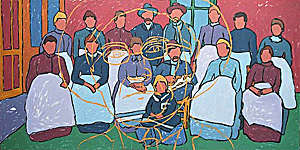
Josephine Roche was born into a wealthy family from Neligh, Nebraska. Educated at Vassar and Columbia University, Roche received a master’s degree in social work and dedicated herself to labor politics and fighting for safe working conditions. She was Denver’s first policewoman and later served as a probation officer for juvenile offenders. Roche lost Colorado’s gubernatorial primary in 1934, but was awarded a cabinet post under President Franklin D. Roosevelt as the assistant secretary to the Treasury and overseer of the U.S. Public Health Service.
Mary Rippon
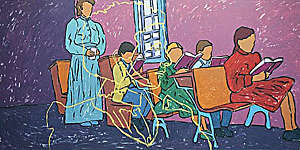
Mary Rippon was born in northeastern Illinois in 1850. Rippon studied in Germany and France for many years and in 1878, she began teaching at the University of Colorado (CU), soon after the school’s founding. She taught German literature, becoming one of the nation’s first women professors, one of the first women to teach men in a university classroom, and the first women to teach at CU. Rippon eventually became the head of the Department of Germanic Languages and Literature.
Teresita Sandoval
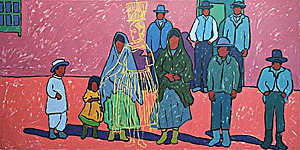
Teresita Sandoval was born in 1811, in Taos, New Mexico. In 1835, Sandoval met Mathew Kinkead, a naturalized Mexican citizen and a Kentucky native, in Mora, New Mexico. They moved to the Arkansas River and formed a trading partnership with a culturally mixed community. This group founded El Pueblo, present day, Pueblo, Colorado.
Susan Anderson

Born in Indiana in 1870, Susan Anderson attended the University of Michigan Medical College and graduated at a time when only five percent of all doctors were women. She followed her family to Cripple Creek where she tended to miners seeking their fortunes in gold. She tried to practice in Denver and Greeley, but the communities were not ready for a female doctor, so she moved to Fraser were she was able to renew her medical practice. Anderson’s successes led to her selection as a railroad doctor, county coroner, and sheriff’s deputy.
Elizabeth Ensley
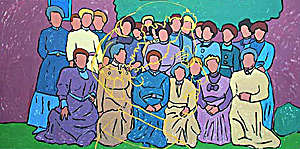
Elizabeth Ensley was an influential African American civic leader in Colorado. Born in the East, Ensley moved to Colorado with her husband in 1890. Ensley helped found the Women’s League in 1894, was treasurer of the Equal Suffrage Association, and she founded the Colorado Association of Colored Women’s Clubs in 1904. Ensley wrote about Colorado’s first election in which women voted (1894) for the Woman’s Era, the publication of the National Association of Colored Women.
Chipeta

Born in 1843, Chipeta grew up near present day Conejos, Colorado. She was a member of the Umcompahgre, Ute tribe and married Chief Ouray when she was 16. Chipeta befriended white settlers and legend has it that she had a role in rescuing and housing hostages in the Meeker Massacre. Chipeta and Ouray went to Washington, D.C. to negotiate a treaty with the United States government. The U.S. did not ratify the treaty and the Ute tribes were forced to move to a reservation in Utah.
Lily Chin
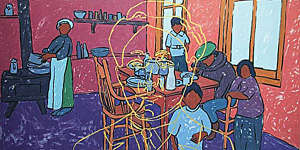
Known as the first Chinese American child born in Colorado, Lily Chin was born on December 3, 1873 in Black Hawk. Chin eventually moved to Denver where she met and married Look Wing Yue, a Chinese merchant. The two of them ran a profitable Chinese merchandise store in downtown Denver. Chin was known for beauty, intelligence, and education.
Margaret Brown
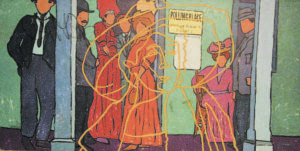
Margaret Tobin was born in Hannibal, Missouri and followed her brother to the silver mining community of Leadville, Colorado in 1885. She married James J. Brown in 1886 and moved to Denver after becoming wealthy in Leadville. The Browns separated in 1909, and Mrs. Brown began traveling. She is best known for having survived the sinking of the Titanic in 1912. Brown was active in the struggle for women’s suffrage and ran for the U.S. Senate eight years before women across the country could vote.
Virginia McClurg
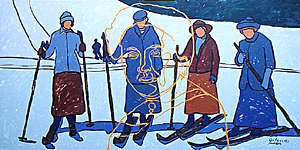
Virginia McClurg was one of the first people to foster an appreciation for the landscape’s aesthetic and historical importance. Raised in New York City and educated in Virginia, McClurg became a well-known writer and traveled west in 1877. She was one of the first white women to view the prehistoric cliff dwellings near Mesa Verde, which began her lifelong interest in preserving Colorado’s Native American sites. Until her death in 1931, McClurg raised money to support restoration work in the park and wrote about the beauty of Mesa Verde’s landscape.
Dana Crawford

Dana Crawford was born and raised in Salina, Kansas. She was educated at the University of Kansas and at Harvard-Radcliffe’s Business Management Program. Crawford moved to Denver in 1954, and became a leader in preserving Denver’s historic buildings and revitalizing decayed neighborhoods. She is a founding member of Historic Denver and was instrumental in the preservation of Larimer Square, Denver’s first historic district. The success of Crawford’s work inspired more preservation work in LoDo, and she continued to select, preserve, and adapt significant buildings. A pioneer in the urban preservation movement, Crawford has been honored with the nation’s highest award in historic preservation, the Louis du Pont Crowninshield Award.
